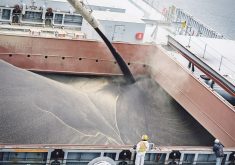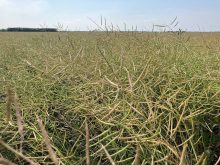Farmers who fill their 25,000 litre fuel tanks this winter, only to see the price drop by 10 cents per litre afterward, stand to lose $2,500 compared to what they could have paid.
Is there any way to hedge that?
That’s the kind of question financial experts say farmers need to think about, and the kind of work marketing advisers try to convince farmers to do.
“A big part of our strategy is locking in margins,” said Agri-Trend Marketing manager Derek Squair.
Read Also

Short rapeseed crop may put China in a bind
Industry thinks China’s rapeseed crop is way smaller than the official government estimate. The country’s canola imports will also be down, so there will be a lot of unmet demand.
“We try to match it up dollar for dollar.”
In other words, for every dollar of fertilizer, diesel or chemicals bought, farmers are encouraged to sell one dollar’s worth of a future crop — usually canola.
That way the input price is covered by the sales price and farmers will not be vulnerable to price swings in the long period between when they buy inputs and when they sell the harvested crop.
Canadian Federation of Agriculture president Ron Bonnett, who took part in a panel discussion with Bank of Montreal agricultural lenders about their bank’s recent farm financial and production outlook, said farmers need better ways to protect the price spread between input prices and crop or livestock sales.
“We’ve had a lot of discussion in our organization and in some of the commodities about really taking a look and seeing if there are other tools that we can put in place and be able to hedge some of our costs against what our future sales are going to be,” said Bonnett.
BMO Saskatchewan lending manager Glen Snyder said farmers are often good at hedging the sales price of their crops, and buying various forms of crop and revenue insurance, but few are able to effectively hedge their input exposure.
“There needs to be much more focus on the expense items, the risk management there,” said Bonnett.
But that’s difficult, say marketing advisers.
Jon Driedger of FarmLink Marketing Solutions said diesel prices can be hedged using NYMEX heating oil futures, but natural gas futures often do not offer a reliable proxy for fertilizer prices. Natural gas is the main component in nitrogen fertilizer.
“That relationship is pretty loose,” said Driedger about the fertilizer-natural gas spread.
“I certainly wouldn’t recommend it.”
He shares Squair’s view that forward sales of crop matched to present purchases of inputs can cover the purchase price of the inputs and eliminate that portion of the risk.
Especially now, with fertilizer prices high, Driedger said his firm discourages farmers from buying much fertilizer unless it’s matched by a sale.
“I think it’s too risky to leave it totally naked (at today’s fertilizer prices),” said Driedger.
Squair said his company assesses a farmer’s input price risks and then hedges them out, with the riskiest inputs — usually fertilizer because of its price volatility — hedged first.
If a farmer is going to buy $100,000 of fertilizer, he’ll sell $100,000 of next year’s canola.
“We do buying and selling decisions based on those risk ratings,” said Squair.
While using heating oil futures as a facsimile for diesel, or making big sales of canola to cover a big purchase of fertilizer, can be a chancy process, the advisers said often the hardest part of the risk management process is convincing the farmer that purchased inputs are still a financial risk even after they have been paid for. And they don’t like locking in next year’s crop prices in order to hedge an expense they’ve already paid out.
“We have a lot of clients that don’t like forward pricing canola, but they don’t have any problem buying fertilizer six months or eight months or 10 months in advance,” said Squair.















